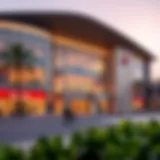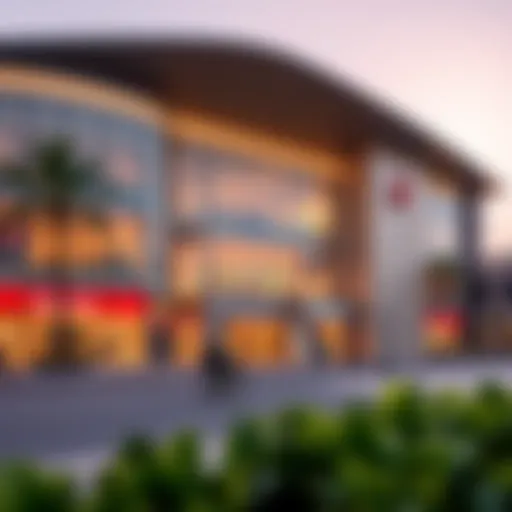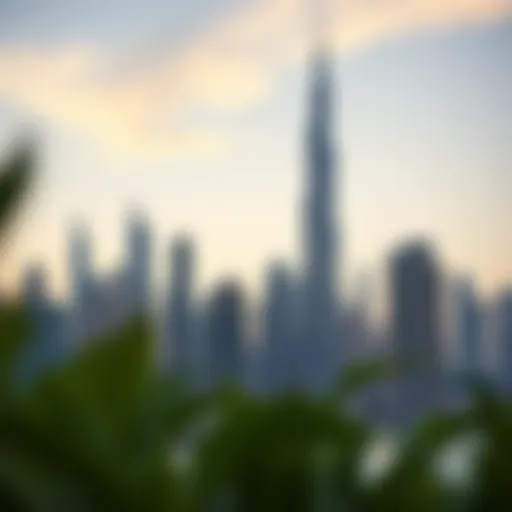Exploring the Fontaines of Burj Khalifa
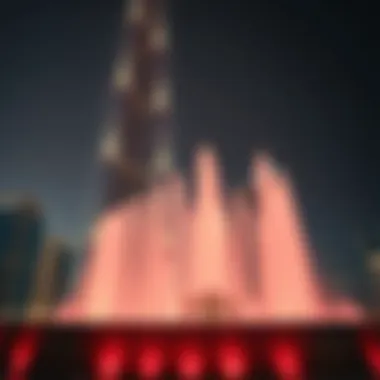
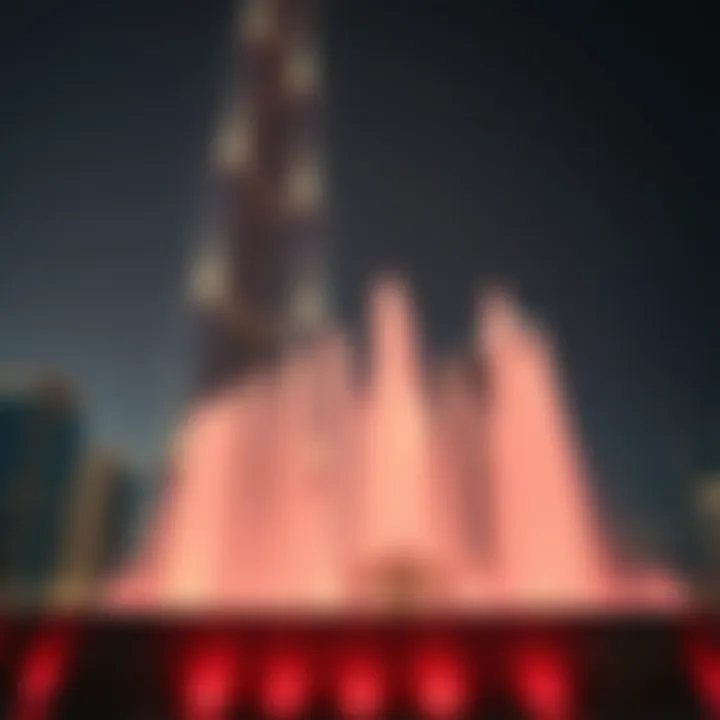
Intro
The Burj Khalifa stands tall, a shimmering beacon of innovation in the heart of Dubai, but few know that its glory is complemented by an equally spectacular feature—the Fontaines. Stretching across a vast expanse, these water jets create a mesmerizing dance of water and light, capturing the hearts of tourists and locals alike. In this article, we dive into the technical marvel and enduring appeal of the Fontaines, exploring how they influence Dubai's real estate market and tourism sectors.
As the largest choreographed fountain system in the world, the Fontaines of Burj Khalifa are not just a visual spectacle; they embody the spirit of modern Dubai. By combining technology, art, and culture, these fountains play a significant role in the city’s identity. Our exploration will reveal the depths of their significance, the technology that powers them, and how they interlace with the urban fabric of Dubai.
Throughout this piece, we'll shine a light on various aspects, beginning with the market trends that dictate the demand for properties around Burj Khalifa and how the allure of the Fontaines contributes to that demand. Additionally, we’ll provide practical advice for those looking to invest in or rent properties near these water wonders. Let’s embark on a detailed journey into the Fontaines, uncovering their impact on Dubai's skyline and economy.
Prologue to the Fontaines of Burj Khalifa
The Fontaines of Burj Khalifa stand as a remarkable testament to the harmonious blend of art and engineering that defines Dubai's skyline. They are not merely decorative elements; they embody the spirit of innovation that characterizes the United Arab Emirates. Understanding the nuances of these fountains is vital, considering their role as a cultural and social hub within the Dubai landscape.
Overview of Burj Khalifa
The Burj Khalifa, soaring at a staggering height of 828 meters, reigns as the tallest building in the world since its inauguration in 2010. But beyond its architectural might, it serves as a focal point for both residents and tourists. The Fontaines, strategically positioned around the base of the tower, create a stunning visual spectacle that attracts thousands of visitors daily. These fountains span over 30 acres and feature a choreography that rivals any well-orchestrated performance.
Dubai is often viewed through a lens of luxury and excess, but the Burj Khalifa and its Fontaines tell a different story—one where ambition and artistry coalesce to create an unforgettable urban ambiance. The brilliant juxtaposition of water, light, and music adds a layer of depth to the overall experience of being in Dubai, marking it as a significant point of interest for investors, designers, and tourists alike, eager to unravel what makes this destination so captivating.
Historical Context of the Fontaines
The genesis of the Fontaines can be traced back to the vision of the Dubai government to position the emirate as a leading tourist destination. Conceptualized by a team from WET Design, the fountains were designed to complement the architectural grandeur of the Burj Khalifa, serving as both a functional water feature and a symbol of modernity.
Initially completed in 2009, the Fontaines have gone through various iterations to maintain their appeal and technological prowess.
- Cultural Influences: The design drew inspiration from traditional Arab water features, which historically played crucial roles in community gathering and social cohesion.
- Technological Advances: The continual updates made to the fountain systems reflect not only advancements in technology but also a commitment to sustainability and resource conservation, which is an ever-growing concern in modern urban development.
Ultimately, understanding the historical context of the Fontaines of Burj Khalifa unveils their significance not just as mere attractions, but as integral components of Dubai's urban identity, symbolizing its rapid evolution and the ethos of its diverse culture.
"These fountains are a choreographed dance between nature and technology, representing the endless possibilities of what human ingenuity can achieve."
In reflecting on these elements, one recognizes that the Fontaines are more than a sight to behold; they are emblematic of Dubai's aspirations, identity, and the cultural tapestry that continues to evolve within this dynamic city.
Design and Architecture
The design and architecture of the Fontaines of Burj Khalifa are not merely aesthetic elements; they represent a harmonious blend of innovation, culture, and functionality. This remarkable fountain system is a testament to Dubai's commitment to pushing boundaries and reimagining urban spaces. In understanding this section, one can appreciate how carefully crafted designs can create an emotional resonance with both residents and tourists.
The Vision Behind the Design
At the heart of the Fontaines lies a vision that transcends traditional fountain concepts. Conceived as part of the broader Dubai Downtown project, the fountain was meant to be a celebration of water, light, and movement. The ambitious vision was driven by the desire to not only capture attention but to also symbolize the cultural values of unity and creativity. Since water has always held a significant place in Arabic culture, the fountain’s design seeks to honor this heritage.
The interplay of water jets reflecting patterns and choreographed movements evokes the feeling of a dance—a metaphor for harmony in diversity. Here’s a point to note: this fountain is not just a flow of water; it’s an experience that resonates with people on multiple levels.
Collaboration of Architects and Engineers
The collaboration between architects and engineers on this project has been nothing short of remarkable. The renowned architectural firm, Skidmore, Owings & Merrill (SOM), played a pivotal role in creating not just the Burj Khalifa but also the surrounding landscape, including the fountains. Engineers worked hand-in-hand with creative designers to ensure that the mechanics of the fountains aligned perfectly with the architectural vision.
This collaboration bore fruit in striking ways — the engineers had to devise mechanisms that can withstand environmental factors such as wind and temperature variations, while the architects insisted on maintaining a fluid aesthetic that suggested grace and movement. Together, they have succeeded in creating a fountain that can execute complex choreographies without losing its elegance.
"Great architecture doesn’t just serve visual pleasure; it enhances the experience of a space, turning it into something unforgettable."
Material Selection and Construction Techniques
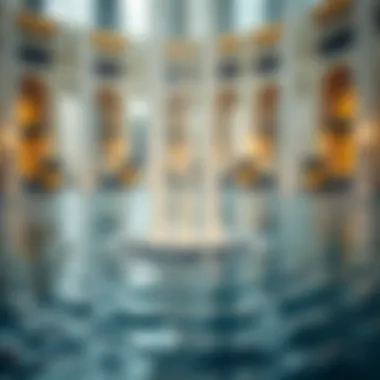
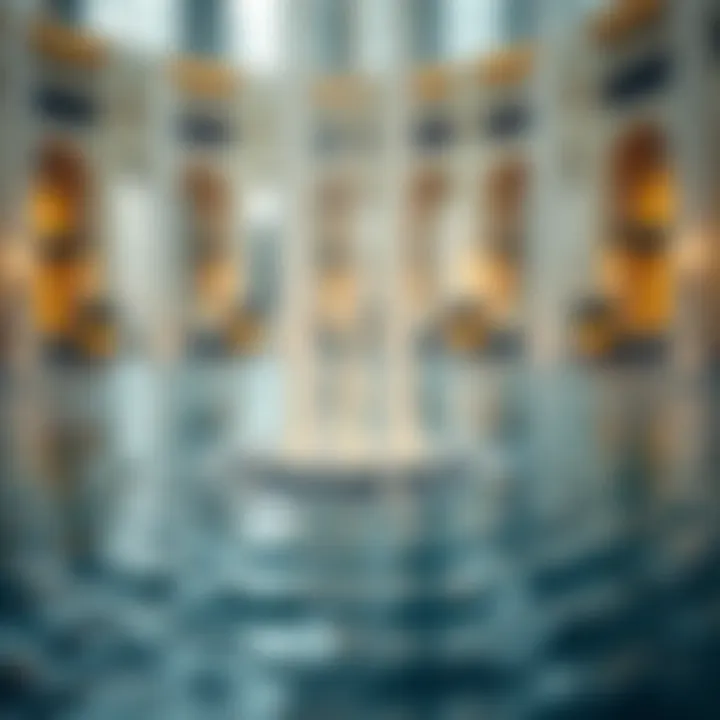
Choosing the right materials and construction techniques was essential to fulfill the grand vision of the Fontaines. The fountains are equipped with state-of-the-art nozzles that can shoot water heights of up to 150 meters, creating a spectacle that can be seen from miles around. The materials had to be durable and able to withstand the elements while still being environmentally friendly.
Among the materials used are stainless steel for the nozzles and reinforced concrete for structural support. These choices ensure longevity without compromising the look of the structures. Construction techniques involved precision engineering practices that allowed for accurate installations without disrupting the surrounding urban fabric.
Technical Specifications
Understanding the technical specifications of the Fontaines of Burj Khalifa is crucial for grasping how this magnificent water feature operates. Beyond mere aesthetics, these elements significantly contribute to the fountain's capabilities in terms of performance, energy efficiency, and overall experience for the audience. The right balance of technology and design is what makes the Fontaines not just a visual spectacle but also a feat of engineering.
Fountain Mechanics and Technology
The mechanics of the Fontaines are engineered with precision, allowing for a choreography that mimics an intricate dance. At the heart of it is a water propulsion system that utilizes a series of pumps, strategically placed to enable various heights and patterns of water sprays. Each nozzle can be adjusted to respond dynamically, providing a unique performance with each show. The system allows a single fountain to shoot water up to 150 meters high, which is truly stunning against the backdrop of Burj Khalifa.
To ensure seamless operation, the mechanics are complemented by a sophisticated control system which synchronizes all elements of the performance. The software processes commands at lightning speed to adjust the water jets instantaneously and achieve precise heights and effects. This level of precision ensures that every performance is not only visually striking but also well-coordinated with accompanying music and lighting.
Water and Lighting System
The water and lighting components of the Fontaines operate in a synchronized symphony. The water system is designed to manage vast volumes efficiently while maintaining clarity and quality. Water is circulated from the nearby Burj Lake, where it undergoes treatment to keep it clear of any debris or pollutants. To add to the visual splendor, the lighting system employs over 6,600 lights and 25 colored projectors, with each light carefully positioned to enhance viewer experience at various times of the day.
These lights are not just standard fixtures; they are equipped to change color and intensity, which adds depth to the performance. This means that when the fountains are in action, they’re not just spraying water; they’re transforming the environment into a multidimensional tableau that captivates onlookers.
Synchronization with Music
The synchronization of fountains with music is perhaps one of the most enchanting features that elevates the entire experience. Each performance is set to a carefully curated playlist, ranging from classical pieces to contemporary tracks, providing an auditory backdrop that enhances the visual spectacle. The synchronization technology ensures that the water jets move precisely in time with the music's rhythm and beats.
This level of coordination is achieved through a complex system that analyzes the sound input in real-time. As the music plays, the software calculates the timing for each fountain jet's action, producing a cohesive performance that makes the spectacle feel like a well-rehearsed ballet. For many visitors, witnessing this blend of water, light, and sound is what solidifies their memory of the Burj Khalifa, making it an unforgettable experience.
"The fountains are not merely water displays, but an exquisite amalgamation of technology, artistry, and cultural expression."
Cultural Significance
The Fontaines of Burj Khalifa represent more than just an impressive display of water. They are a microcosm of Dubai's identity, interwoven with local traditions and aspirations. Understanding their cultural significance enables a more profound appreciation for what they represent to both residents and visitors.
Symbolism in Local Culture
The significance of the Fontaines goes beyond their aesthetic appeal; they embody various elements of local culture. In many ways, they can be seen as a reflection of the prosperity of Dubai. The intricate choreography of water—dancing and leaping in sync with music—mirrors the harmony found within Emirati culture, where community and tradition are vital.
The rhythmic flow of the water encapsulates the essence of life in the desert—a reminder of the vital importance of water in arid environments.
Furthermore, the fontaines stand as a symbol of trust in innovation while still honoring historical roots. The fusion of modern engineering with traditional artistry showcases a dedication to both progress and heritage; it’s like threading the needle between the past and the vibrant present.
- Represents abundance: In a land where resources are scarce, the constant flow of the fountains symbolizes the prosperity that Dubai has achieved.
- Cultural pride: The construction and design were influenced by Islamic art and architectural elements, slyly hinting at the beauty of the region’s rich heritage.
- Collective identity: Locals and tourists alike flock to witness the spectacle, creating shared experiences that foster a sense of belonging.
Artistic Representations and Performances
Art in different forms thrives around the Fontaines of Burj Khalifa. Various events, performances, and artistic endeavors emerge that resonate with the local populace.
Examples include seasonal celebrations during Ramadan or cultural festivals where the fontaines take center stage, displaying specially choreographed shows that blend music, light, and water. These spectacles are not simply entertainment; they serve as an expressive outlet for local artists to showcase their creativity on a grand scale.
Such performances are akin to a canvas brought to life, reflecting the diverse artistic influences that characterize Dubai as a melting pot of cultures, each adding its stroke to the vibrant palette.
- Local engagement: Community members often get involved in these performances, creating a tapestry of artistic expression that fosters unity.
- Inspiration for artists: The fountain's aesthetics have spurred various forms of art, from photography to paintings, inspired by its elegance.
- A cultural beacon: The fontaines have become iconic, a touchstone in Dubai's cultural narrative, attracting global attention and discussion.
Economic Impact
When exploring iconic landmarks like the Fontaines of Burj Khalifa, it’s essential to consider their economic ramifications. These spectacular water features do not merely serve as aesthetic enhancements; they play a vital role in reshaping Dubai’s economy by contributing to various sectors, including tourism, real estate, and employment.
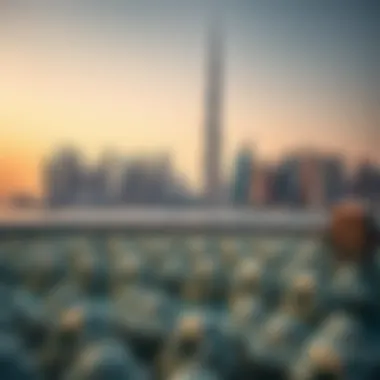
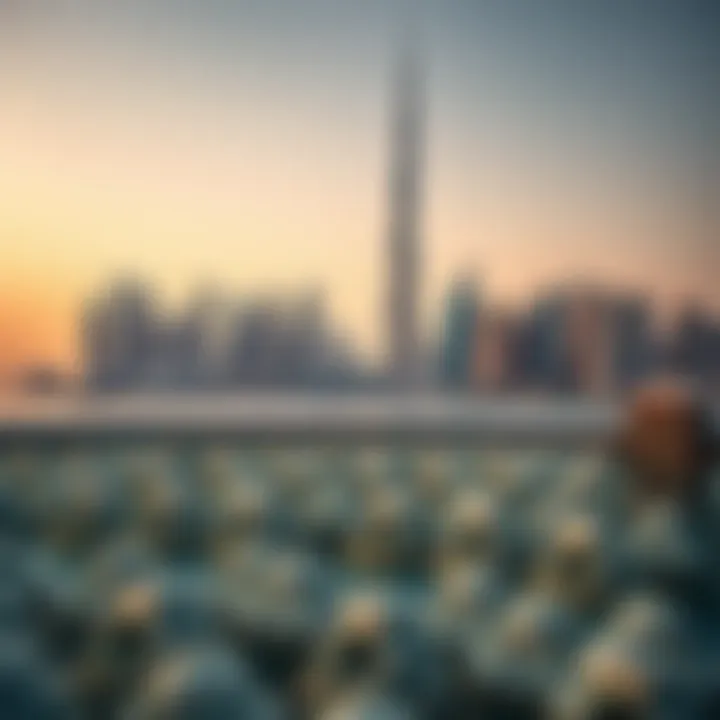
Tourism Contributions
Tourism is one of the cornerstones of Dubai’s economy, and the Fontaines significantly bolster this sector. Each year, millions flock to witness the mesmerizing displays of water choreography, which are set against the stunning backdrop of the Burj Khalifa. This attraction alone draws not just locals but tourists from every corner of the globe, imparting a tangible economic benefit.
- The unique experience of watching the Fontaines, particularly the night-time shows, encourages visitors to linger longer in the area.
- Nearby dining establishments and boutiques also witness a surge in patronage, contributing to the local economy.
- Events, inspired by the fountain shows, often attract various festivals, further amplifying tourist inflow during peak seasons.
Real Estate Development Around Burj Khalifa
The presence of the Fontaines has significantly enhanced property values in the surrounding areas. Developers and investors are increasingly keen on capitalizing on the allure of the Burj Khalifa and its mesmerizing fountains.
- Residential and commercial properties within proximity to this landmark often see increased demand. Buyers value proximity to such iconic features, enhancing overall property market confidence.
- Development projects have sprouted, including luxury hotels, upscale apartments, and vibrant retail spaces designed to ensure that residents and visitors have uninterrupted views of the Fontaines.
"The enchanting allure of the Fontaines has made real estate investments in this area a wise choice, as they ensure both growth and a unique living experience."
Employment Opportunities Created
The economic impact extends even further into job creation. The operational aspects of the Fontaines and related businesses generate numerous job opportunities, contributing to local employment rates.
- Direct Jobs: The maintenance, operation, and programming of the fountains require skilled technicians and artists, creating specialized roles.
- Indirect Opportunities: The influx of tourists leads to a higher demand for services, resulting in more jobs in hospitality, retail, and transport sectors.
These jobs not only provide livelihoods for the locals but also foster a sense of community pride, given their involvement in showcasing a globally recognized attraction. Each function contributes to a more robust economic ecosystem, thanks to the Fontaines. In this way, the economic impact of the Fontaines of Burj Khalifa is profound, extending further than just visual aesthetics, intertwining deeply with the prosperity of the Dubai region.
For more insights on the economic climate in Dubai, visit Wikipedia and Britannica.
Visitor Experience
The Visitor Experience at the Fontaines of Burj Khalifa is not just about witnessing an extraordinary display of water and light; it encapsulates a moment in time where technology, art, and nature converge. This experience represents a unique blend of sensory engagement, cultural immersion, and sheer spectacle, drawing millions of visitors each year to Dubai. For investors, agents, and even designers, understanding the nuances of this experience can provide insights into its significant impact on tourism and consumer engagement, thereby influencing market trends.
Observation Points and Viewing Areas
When it comes to enjoying the show of the Fontaines of Burj Khalifa, picking the right observation point can make all the difference. The main viewing areas include the Dubai Mall, the promenade surrounding the Burj Khalifa Lake, and dedicated viewing decks. Each location offers its own vantage point, tailored to enhance the visitor experience in unique ways.
- Dubai Mall houses prominent restaurants and cafes, perfect for those who enjoy dining while watching the performance. Visitors can grab a bite at a terrace overlooking the fountains, providing a moment of leisure before the show starts.
- Burj Lake Boardwalk offers an unobstructed view with an immersive walking experience. This pathway allows visitors to feel the mist from the fountains, connecting them physically to the performance.
- At the Top, Burj Khalifa observation deck presents a bird's eye view, making the fountains seem like mere drops of water. However, this perspective is equally stunning, as it showcases the grand scale of the choreographed dance from above.
Each spot offers a different flavor of the fountain’s artistry, making it essential for guests to choose based on their preferences. Furthermore, as the seasons shift, certain areas become more popular due to surrounding events and festivities, which indeed influences foot traffic and visitor engagement.
"The nightly fountain shows are choreographed to various genres, from classical to contemporary music, creating a mosaic of emotions and sensations for every onlooker."
Seasonal Events and Festivals
Dubai is a city that thrives on celebration. The Fontaines are no exception, as they become a focal point during various seasonal events and festivals, adding another dimension to the visitor experience. These events not only attract tourists but also foster a sense of community among residents.
During the Dubai Shopping Festival, the fountains offer special light shows that are more elaborate than usual, often synchronized to popular music. The festive atmosphere draws in crowds, enhancing the overall buzz of the event. Similarly, during the Eid celebrations, themed performances reflect the festive spirit, allowing visitors to experience cultural significance alongside the spectacle.
Moreover, the New Year's Eve celebration at Burj Khalifa is a grand affair, with breathtaking fireworks and a fountain show to match. Attending this event is akin to being part of a global gathering, as millions tune in worldwide. Experience seekers are treated to an unforgettable night, with the fountains serving as a backdrop to this iconic moment.
To fully embrace the array of experiences available, visitors should check local calendars for upcoming events, ensuring they don’t miss out on any seasonal spectacles. This not only enriches the experience but also underscores how the Fontaines integrate into the fabric of Dubai’s cultural and social life.
Comparative Analysis
In examining the Fontaines of Burj Khalifa, it is essential to place their design and functionality within a broader context of fountain systems around the globe. This comparative analysis serves not just as a measure of the Fontaines’ excellence, but also as a lens through which we can view innovation, culture, and engineering habits in public attractions. Understanding how these magnificent waterworks stack up against others worldwide offers deeper insights into their technological marvels, aesthetic appeal, and the unique cultural narratives they embody.
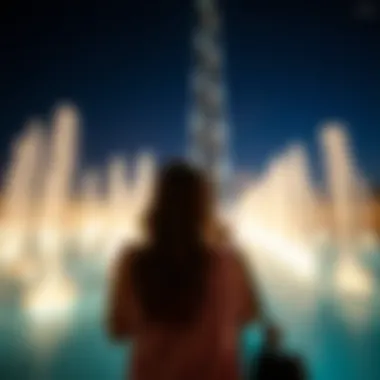
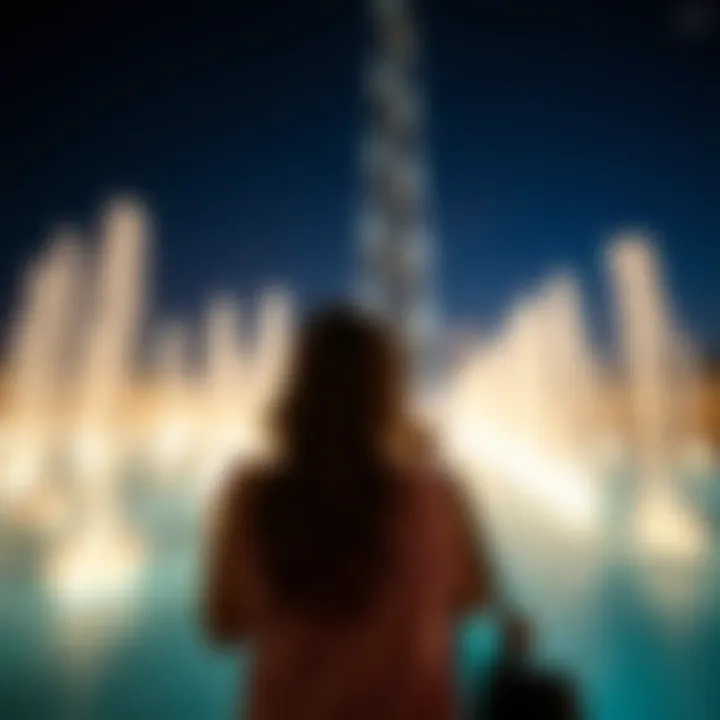
The importance of this analysis lies in its ability to identify distinct features and innovations that set the Fontaines apart from their global counterparts. Factors such as water choreography, scale, and integration with architecture help illuminate the reasons why Burj Khalifa's fontaines have become a focal point for both residents and tourists. Thus, this narrative progresses beyond sheer admiration and delves into the implications of such a spectacular installation in the context of urban development and entertainment.
The Fontaines vs. Other Global Fountain Systems
When comparing the Fontaines of Burj Khalifa with other fountain systems globally, a few key elements come into play:
- Scale and Magnitude: The Burj Khalifa Fontaines spread across a whopping 30-acre manmade lake, featuring water jets that shoot as high as 150 meters. Unlike the Bellagio Fountains in Las Vegas, which offer a dazzling display, the Burj Khalifa's fountains operate on a larger scale, signaling Dubai's ambition.
- Choreographed Shows: The musical synchronization in Burj Khalifa's Fontaines is engineered with precision. While other fountains, like those in Paris’ Place de la Concorde, incorporate music, the Fontaines’ elaborate audio-visual narrative aligns with a sophisticated spectrum of musical compositions, adding layers to the experience.
- Technological Integration: Many global fountain systems utilize basic water mechanics. However, the Burj Khalifa exemplifies advanced technology, employing state-of-the-art control systems that monitor water flow and light intensity dynamically, improving resilience and enhancing the visual spectacle.
In a recent survey, over 80% of global visitors expressed that the experience at the Burj Khalifa Fontaines was more immersive than other famous fountains. This statistic underlines the successful integration of artistic expression, leading-edge technology, and cultural resonance.
Influences on Fountain Design Worldwide
The impact of the Fontaines of Burj Khalifa transcends its immediate locale, influencing fountain designs globally in a variety of ways. The advanced hydraulic technologies and precise choreographic frameworks utilized here have spurred architects and engineers to think outside the box.
- Adoption of Choreography: Many cities have begun to explore synchronized water and light displays as a means to enrich public spaces. For instance, the Dubai Fountain's design has contributed to similar projects in places like the Marina Bay Sands in Singapore.
- Cultural Programs: Inspired by the notion of community engagement seen at the Burj Khalifa, other cities have begun incorporating cultural performances alongside their fountain shows. This has manifested in places like Shanghai, where local artists perform alongside water displays to foster a sense of belonging and pride among residents.
- Architectural Harmony: Architectural firms globally are now looking for ways to integrate monumental fountains into urban designs seamlessly. The Burj Khalifa demonstrates how a fountain can enhance a building’s aesthetic, encouraging the inclusion of water features in future skyscrapers.
In summarization, the Fontaines of Burj Khalifa not only set a high bar for fountain design but also create ripples of influence that extend into how future water displays will be conceived. These contributions highlight the importance of marrying engineering marvels with rich cultural narratives, ultimately serving as inspiration for other cities and architects across the globe.
Future Prospects
The Future Prospects of the Fontaines of Burj Khalifa stands as a critical area of exploration, intertwining technological innovations with sustainable practices. In an era where environmental consciousness shapes development agendas, the evolution of fountain systems isn't just about aesthetics. It reflects a progression toward sustainable urban design, balancing beauty and ecological responsibility. Investors, buyers, agents, designers, and analysts will find that understanding these future directions can influence not just perceptions but also market value in Dubai’s evolving landscape.
Technological Advancements in Fountain Design
As we delve into the realms of innovation, it's evident that technological advancements are at the forefront of fountain design. Looking towards the horizon, we anticipate further integration of automation and smart technology in the Fontaines of Burj Khalifa. Future designs might utilize enhanced sensor technologies that adapt to real-time environmental conditions and visitor engagement levels, essentially creating a dynamic relationship between the fountain and its audience.
Some prospective advancements could include:
- Internet of Things (IoT): Connections that allow seamless communication between the fountain systems, ensuring synchronized performances that respond to immediate surroundings.
- Energy-efficient technology: Designs that maximize energy savings and utilize renewable energy sources, leading to lower operational costs and a lighter ecological footprint.
- Advanced water purification systems that enable less frequent water changes, keeping the display pristine while conserving water resources.
Such technological shifts not only heighten the visual experience for visitors but also attract a demographic that appreciates sustainability. This opens up additional avenues for attracting high-end developers and eco-conscious investors, creating a ripple effect in the surrounding real estate market.
Sustainability Considerations
The integration of sustainability in fountain design is no longer negotiable; it's essential. As the Fontaines of Burj Khalifa continue to dazzle visitors, their future must align with practices that protect the environment. Sustainable features could unfold in numerous ways:
- Water-efficient systems: Implementation of recirculation strategies and advanced filtration that lessen water consumption, proving that opulence and resource conservation can coexist.
- Biodiversity considerations: Landscapes around the fountains could include native flora that require minimal water, providing natural habitats and enhancing the local ecosystem.
- Community involvement: Engaging local artisans in creating components of the fountain can cultivate a blend of cultural heritage and community pride, fostering an inclusive approach to both its design and maintenance.
In light of these considerations, it's clear that the future of the Fontaines, and by proxy the urban landscape of Dubai, rests on how well these systems adapt and evolve. > "Future innovations must not only captivate the eye but must also harmonize with our planet, promoting a legacy of sustainability alongside grandeur."
Epilogue
Wrapping it all up, the Fontaines of Burj Khalifa serve as a crucial piece in understanding not only Dubai's architectural achievements but also its cultural tapestry. This detailed exploration has presented insights into how these magnificent water features do more than just entertain.
Summary of Key Insights
The Fontaines are not mere decorations; they symbolize the ambition and innovation that define Dubai today. Here are some key takeaways:
- Technical Marvel: The engineering behind the Fontaines showcases cutting-edge technology, setting a benchmark for fountain designs worldwide.
- Cultural Significance: They play a vital role in the local culture, resonating with themes of unity and connection in a city known for its diversity.
- Economic Driver: Contributing significantly to tourism, they draw visitors who contribute to the local economy. This, in turn, boosts real estate values in the surrounding areas, making it a win-win for investors.
- Aesthetic Appeal: The mesmerizing performances elevate the city's skyline and create lasting memories for visitors and residents alike.
The Lasting Legacy of the Fontaines
The Fontaines of Burj Khalifa are set to remain a vital part of Dubai’s identity for years to come. Their blend of art, culture, and state-of-the-art technology only enhances their significance. As they continue to captivate audiences, these fountains are not just structures; they are narratives that embody the spirit of innovation and aspiration prevalent in Dubai.
This legacy will likely influence future fountain designs globally, as cities look to replicate the success and cultural impact that the Fontaines have achieved. In summary, the Fontaines embody the ethos of a city that dares to dream big, serving as a reminder of what can be accomplished when vision meets execution.
Ultimately, they are a testament to the human spirit’s ability to create beauty and wonder, which is why they hold such a special place in the landscape of Dubai and, by extension, the world.


